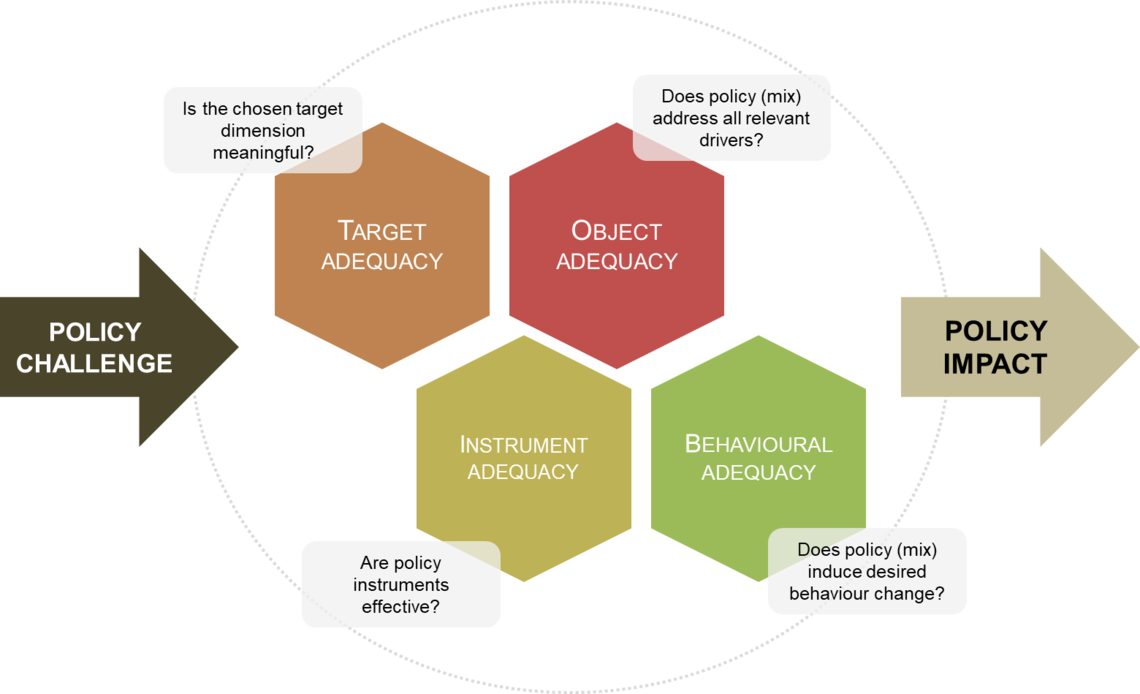Soil governance: overview
Natural resource governance is a complex system with multiple dimensions, encompassing a range of objectives, values, institutions (the "rules of the game") and actors (stakeholders). Four main dimensions of a governance system can be distinguished, within which adequate choices and structures are required in order to make the system functional. These four dimensions are depicted in the Figure below: targets/objectives, objects/drivers of environmental degradation, instruments/institutions and behavioural characteristics of relevant actors. All these dimensions are relevant for the analysis and design of agricultural soil governance, and all are addressed in the context of BonaRes.
Note that the primary focus of governance research in BonaRes is on policy and policy instruments. Other aspects of governance, such as informal institutions, play a minor role.
Disruptions framework

Soils are an essential, slowly-renewable resource that is the foundation of all terrestrial ecosystems. As such, it is of profound importance for human well-being. Agricultural soils are particularly relevant in this context, as they are the basis of most food production. At the same time, well-functioning soils provide or contribute to the provision of multiple ecosystem services other than food. These include carbon sequestration and storage, water filtration and regulation, biological control (Paul et al. 2021; Vogel et al. 2019).
Well-functioning soils may thus contribute to the achievement of multiple Sustainable Development Goals (SDGs), particularly goals 2 (end of hunger, food security and sustainable agriculture), 12 (sustainable consumption and production), 13 (climate change mitigation and adaptation) and 15 (sustainable use of terrestrial ecosystems). At the same time, the demands on agricultural soils are growing – not only because of growing food demand triggered by growing population and increasing affluence, but also because of other, new demands on agricultural land. Many of those demands are related to the bioeconomy – attempts to substitute bio-based for fossil resources in the production of energy and materials.
A challenge is posed by the fact that the different soil functions have different characteristics – including that some are (quasi-)public goods, while other are private goods (Bartkowski et al. 2018). This implies that without any governance interventions, land-users (especially farmers) will focus their management primarily on the private-good soil functions, particularly biomass production, while other functions will remain underprovided. In this multifaceted context, resilient, effective, efficient and legitimate governance is essential (Juerges et al. 2018). Accordingly, governance plays an important role in the research framework of Bonares.
On the following sub-pages you may find information about common types of policy instruments and their relevance in current soil governance; existing overviews of soil-relevant policy instruments at the national and EU level; and the role of governance
research within the Bonares research framework.
- Bartkowski, B., Bartke, S., Hagemann, N., Hansjürgens, B., Schröter-Schlaack, C., 2021. Application of the governance disruptions framework to German agricultural soil policy. SOIL 7(2): 495-509. doi:10.5194/soil-7-495-2021
- Bartkowski, B., Hansjürgens, B., Möckel, S., Bartke, S., 2018. Institutional Economics of Agricultural Soil Ecosystem Services. Sustainability 10(7): 2447. doi:10.3390/su10072447
- Juerges, N., Hagemann, N., Bartke, S., 2018. A tool to analyse instruments for soil governance: the REEL-framework. Journal of Environmental Policy & Planning 20(5): 617-631. doi:10.1080/1523908X.2018.1474731
-
Paul, C., Kuhn, K., Steinhoff-Knopp, B., Weißhuhn, P., Helming, K., 2021. Towards a standardization of soil-related ecosystem service assessments. European Journal of Soil Science 72: 1543–1558. doi:10.1111/ejss.13022
- Vogel, H.-J., Eberhardt, E., Franko, U., Lang, B., Ließ, M., Weller, U., Wiesmeier, M., Wollschläger, U., 2019. Quantitative Evaluation of Soil Functions: Potential and State. Frontiers in Environmental Science 7. doi:10.3389/fenvs.2019.00164

